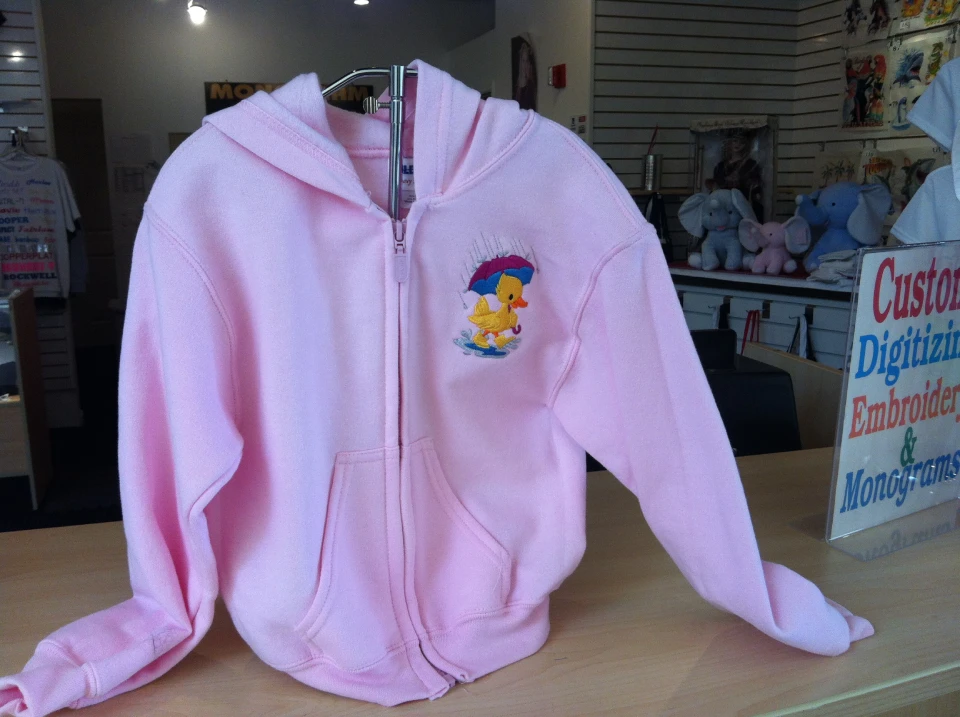Heat Transfer on T-Shirts and Aprons - Customized Styles and Logos
Heat Transfer on T-Shirts and Aprons - Customized Styles and Logos
Blog Article
The Art of Customized Needlework: Opening the Keys to Creating Unique and Memorable Styles
The keys to producing customized embroidery layouts that mesmerize the eye and leave a long lasting impression lie in a fragile equilibrium of technique, creativity, and interest to detail. As we dive right into the world of custom needlework, we uncover the nuanced interaction in between thread option, stitch intricacy, and layout personalization that elevates a plain garment to a work of art.
Picking the Right Needlework Threads
When selecting needlework strings, what key factors should you think about to make sure the finest outcomes for your custom-made styles? The option of needlework string is critical in determining the final outcome of your embroidered layout.
Furthermore, the weight or thickness of the string plays a substantial duty in the appearance of the embroidery. Thicker strings can include measurement and structure to your style, while finer threads are optimal for complex details and small text. In addition, taking into consideration the shade fastness and washability of the string is vital to make sure that your customized styles preserve their quality and vibrancy over time. By carefully evaluating these variables and picking top notch threads that satisfy your particular requirements, you can boost the aesthetic charm and longevity of your embroidered productions.
Exploring Various Stitch Techniques
To look into the realm of 'Discovering Different Stitch Strategies', one should realize the details and nuances that each sewing technique brings to the art of embroidery. Different stitch methods not just add aesthetic interest however additionally contribute to the total texture and measurement of the design. One prominent stitch strategy is the satin stitch, which includes very closely packed parallel stitches to produce a smooth and glossy surface, suitable for completing shapes and producing vibrant outlines.
On the various other hand, the backstitch is a functional technique usually used for laying out and adding fine details. It includes sewing in reverse to create a solid line of embroidery. In addition, the French knot stitch adds a tactile aspect to styles, excellent for developing textured accents like flower centers or attractive touches.
Discovering various stitch techniques allows embroiderers to play with light, shadow, and depth within their styles, boosting the aesthetic allure and imaginative quality of their embroidery projects. By grasping different stitching techniques, one can unlock countless opportunities for developing unique and memorable customized embroidery pieces.
Incorporating Personalized Design Elements
Having explored the intricacies of different stitch techniques such as the satin stitch, backstitch, and French knot, the emphasis now shifts in the direction of including customized design elements in custom needlework tasks. Individualized layout components play a crucial role in making embroidery tasks absolutely one-of-a-kind and unforgettable. One method to incorporate personalization is by including initials, names, or substantial days to the style. This more helpful hints not only adds a personalized touch yet additionally enhances the sentimental worth of the needlework piece.
Another means to incorporate tailored style components is by consisting of symbols or themes that hold unique significance to the recipient or mirror their passions and personality. For instance, integrating a favored flower, pet, or hobby-related icon can make the embroidery layout more significant and personalized. Additionally, selecting shades that resonate with the recipient or line up with the desired motif can even more boost the personalization of the embroidery job.
Understanding the Art of Color Sychronisation
One trick element of shade coordination is recognizing color theory. This consists of knowing exactly how various colors engage with each various other, the emotions they share, and exactly how they can be integrated to produce visually enticing layouts. By applying shade concept principles, embroiderers can produce unified shade palettes that improve the general appearance of the style.
In addition, paying attention to contrast is crucial in color sychronisation. Making use of contrasting shades can help specific aspects of the layout pop, improve legibility, and produce an aesthetically vibrant needlework piece. By mastering the art of color sychronisation, embroiderers can raise their layouts and develop memorable pieces that reverberate with customers and visitors alike.
Enhancing Appearance With Advanced Needlework Stitches

French knots, helpful site as an example, are ideal for adding small, raised dots to your design, simulating the appearance of beads or creating a distinctive surface area. Bullion knots, on the various other hand, can be used to create twisted, ropelike elements that add a luxurious feel to the embroidery. Seed stitching involves tiny, scattered stitches that can fill in areas with a speckled structure, while turkey work creates fluffy, dimensional accents reminiscent of animal fur or vegetation. Experimenting with these advanced needlework stitches permits you to press the borders of typical needlework and develop genuinely special and aesthetically appealing textures in your designs.
Conclusion
In conclusion, the art of More hints personalized needlework involves a mix of picking the ideal threads, exploring numerous stitch methods, incorporating personalized layout aspects, mastering shade sychronisation, and enhancing structure with advanced stitches. By recognizing and carrying out these key elements, embroiderers can develop distinct and memorable styles that showcase their creative thinking and skill. Needlework enthusiasts can open the secrets to developing lovely and bespoke pieces that stand out and leave a long-term impression.
Report this page